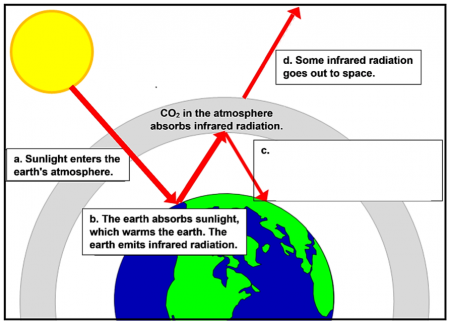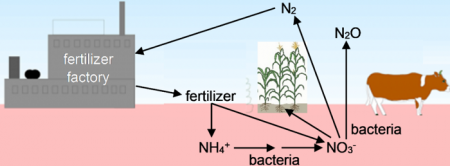Serendip is an independent site partnering with faculty at multiple colleges and universities around the world. Happy exploring!
Teaching Resources for Climate Change
Classroom Activities

Introduction to Global Warming
To begin this minds-on analysis and discussion activity, students learn about the correlated increases in global temperatures and CO2 concentrations in the atmosphere. Next, students evaluate an example that illustrates that correlation does not necessarily imply causation.
Then, students analyze several types of evidence to test the hypothesis that increased CO2 in the atmosphere has been a major cause of the increase in global temperatures. This activity concludes with a very brief discussion of how global warming has contributed to harmful effects (e.g., increased flooding) and possible student actions to reduce these harmful effects.

Food and Climate Change – How can we feed a growing world population without increasing global warming?
In this analysis and discussion activity, students learn how food production results in the release of three greenhouse gases – carbon dioxide (CO2), nitrous oxide (N2O), and methane (CH4). Students analyze carbon and nitrogen cycles to understand how agriculture results in increased CO2 and N2O in the atmosphere.
Students interpret data concerning the very different amounts of greenhouse gases released during the production of various types of food; they apply concepts related to trophic pyramids and they learn about CH4 release by ruminants.
Finally, students propose, research, and evaluate strategies to reduce the amount of greenhouse gases that will be released during future production of food for the world’s growing population.
Global Warming News from the New York Times
- Carbon Capture Comes Back Down to Earth
- Document Shows E.P.A. Plans to Loosen Limits on Mercury From Power Plants
- As Energy Costs Surge, Eastern Governors Blame a Grid Manager
- BlackRock Is Accused of a Plot Against Coal. The Firm Says That’s ‘Absurd.’
- Ocean Temperatures Are Increasing Around the World. See Where.
- In Georgia, Republicans Vote to Kill Green Jobs but Face Little Fallout
- Trump Approves Expansion of Scandal-Hit Coal Mine
Climate Change News from The Guardian
- Drought fears in Europe amid reports May was world’s second hottest ever
- Against the grain: as prices and temperatures rise, can Japan learn to love imported rice?
- A drop in the ocean: does experimental technology hold the key to saving the world’s seas?
- Dead elephants and feral sea lions: how poisonous algal blooms harm the planet
- How does woke start winning again? | Gaby Hinsliff
- Neither glib lines nor warm thoughts can hide the cynicism of Labor’s North West Shelf decision | Clear Air
- New Zealand government sued over ‘dangerously inadequate’ emissions reduction plan
Climate Solutions from Union of Concerned Scientists
- What to Expect When You’re Expecting During Danger Season
- The Crumbling of Bedrock Environmental Policy: We Need to Protect NEPA
- Trump Administration Slashes NOAA, FEMA, Making 2025 Hurricane Season More Dangerous
- ExxonMobil’s 2025 Climate Report Fails Scientific Review—Again
- Wildfires Are Getting Worse. Trump’s Science Cuts Could Threaten Our Response.
- 12,000 Reasons Why the Trump Administration Must Be Stopped from Dismantling FEMA
- Seven Questions for EPA Administrator Lee Zeldin as He Testifies Before Congress
Resources for Teaching and Learning about Climate Change
This annotated list includes resources that can help your students to develop a scientifically accurate understanding of the causes and consequences of global warming and climate change. This list also includes resources for learning about how to reduce greenhouse gases and how to cope with the harmful effects of climate change. When learning about climate change, it is important for students to engage with proposals to mitigate and adapt to climate change, so they can feel energized, instead of powerless. Given the nature of the topic, the approach is interdisciplinary. These resources are appropriate for middle school, high school and/or college students.
